PASINI REPORTS: PMA TRADE SHOW
We Visit a Few Little Booths, a Few Big Booths
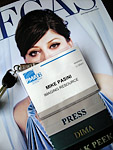 By MIKE PASINI
By MIKE PASINIEditor
The Imaging Resource Digital Photography Newsletter
LAS VEGAS -- When we returned to the PMA trade show floor yesterday after posting a couple of image galleries, we started in the cool confines of the smaller booths. But it didn't take us long to get overheated. We found some exciting things there.
South Hall, which is housing the trade show, is two long exhibit halls, one on top of the other. The trade show is laid out with big booths in the front and smaller ones in the back. Downstairs you walk along a wide main street flanked by Fujifilm/Xerox on the left and Canon on the right past Olympus on the left to Kodak in the middle of the street.
That's where we ended up our Thursday adventure, but we started it upstairs in the back among the little guys with big ideas.
We started out with Eye-Fi (http://www.eye.fi), having heard their praises lauded at the IDC breakfast briefing (http://www.imaging-resource.com/EVENTS/PMAS08/MRP/idc.htm). IDC is a big promoter of WiFi connectivity and that's what Eye-Fi is all about.
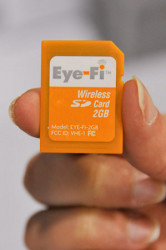
Eye-Fi. Wireless-G and 2-GB storage on the same card.
Except the $99 Eye-Fi packs WiFi (Wireless G) on an SD storage card with 2-GB of space for your photos. Pop it into your SD-capable digicam and you've got a WiFi digicam.
You can transmit your images through a wireless router to your own computer running the company's Eye-Fi Manager software [MW]. They're stored in whatever folder you designate.
Or you can upload your images, again through a wireless router, to any of 20 partners. The Eye-Fi Service works behind the scenes to make sure your shots are formatted for the photo sharing or social networking site you select.
You can't upload to your own FTP server, but you can install the open source Gallery2 (http://www.gallery2.org/) to get your images on your own site.
They've had a lot of interest in a Compact Flash version, Ana Correa told us when we visited. That just may be next. Meanwhile the company has just announced Eye-Fi will be available at Ritz camera stores in addition to online venues.
PORTRAIT QUILTS | Back to Contents
There are plenty of exhibitors who can print on fabric but finding one who sells to the general public isn't easy. We did find Portrait Quilts (http://www.portraitquilts.com) however, where Andy Regitsky told us they don't at all mind selling their quilts to you.
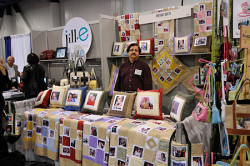
Not Just Quilts. Printed on satin patches.
And not just quilts. The firm offers pillows, pillow shams and tote bags, too, in a variety of sizes. All you have to do is send them your photos. They print them on satin patches which are stitched into the product. The products are all washable, too.
CUSTOM BRACKETS | Back to Contents
We stopped dead in our tracks at the Custom Brackets (http://www.custombrackets.com) booth where a very simple, light but sturdy camera bracket claimed to be "Simply the Best." Not a bad motto, we thought.
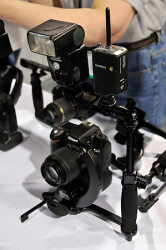
Custom Bracket. Smooth, sturdy, efficient.
"Why's it the best?" we asked.
That led to a quick demo that suggest the bracket wasn't just well built but well designed. A flick of the wrist and the camera traveled on a semi-circular rail from horizontal to portrait orientation, stopped by a detent at either position. That, of course, doesn't change the flash, held by an extension to the bracket, which is the big advantage of a bracket.
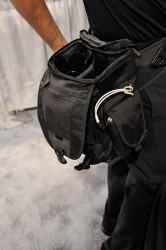
Lens Bag. Designed to be useful when you're working, not just traveling.
It also has a quick release plate so you can get the camera off the bracket or the bracket off a tripod. The quick release mechanism is just a slot through which a pin travels to lock the camera or bracket down.
The full kit, built in Cleveland, Ohio, is $435.
BODA LENS BAG | Back to Contents
Jim Garner was wearing one of boda's new lens bags (http://www.goboda.com). Just lenses. One or two. But with pockets on the side and front for cleaning cloths, lens caps, storage cards, you name it. The top flat folds back and can be snapped to stay open. You can switch from a shoulder strap to a belt very easily, too.
It was, Jim said, designed by photographers for photographers. Then he made a lens change in the blink of an eye, taking off the one on his camera, dropping it into the free slot in the bag (big end up), pulling out the other and locking it to his camera. We got the picture.
Yes, they're working on a camera bag, but the idea is to produce something you can use while you're working, not just traveling. Good idea.
We wrote so much about Kodak in our CES coverage that we were a little relieved to see the company emphasize their commercial division at PMA. We were gingerly avoiding the booth when we ran into Kodak Vice President Nancy Carr.
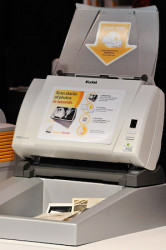
Scan a Stack. Prints or negatives at 40 prints a minute.
She was admiring the company's new Rapid Print Scanner. You can throw prints and negatives at it and it will batch scan them for you. It's a scanning kiosk, in fact. You bring your shoebox to the store, stack your prints in the scanner and get a disc with the scans. And it's quick, doing about 30 prints a minute.
We'll have to return for a closer look. There's certainly a crying need for something like that.
We also ran into Kodak Marketing Manager Jerry Magee who showed us how SmartCapture on the M1033 digicam works. We'd mentioned SmartCapture in our CES report, available for the first time in the Z1085 IS and the M1033. But we didn't get our hands on it.
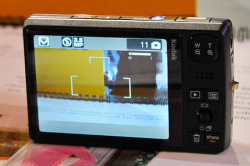
SmartCapture. Note the icon in the top left corner of the LCD indicating the automatic Scene mode selected by the M1033.
In its debut version, SmartCapture picks a Scene mode (although not all Scene modes are supported), sets the white balance and exposure (underexposing a bit) and processes the image (which is why it can underexpose) using a powerful image processor.
We set the M1033 to SmartCapture recording mode and scanned the floor, a nearby face, an object on the table we were sitting at and my notebook. We watched the SmartCapture icon on the LCD change from landscape, to portrait, to macro to text. Our notebook text? Now that is smart capture.
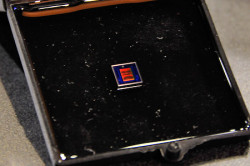
Kodak Camphone Chip. That's five megapixels staring back you smaller than half a fingernail on your pinky.
It seemed a little sluggish, but not as sluggish as we would have been switching Scene modes. It will be fun to see how SmartCapture evolves. Keep your eye on it.
Finally, we spent an exhilarating 15 minutes with Kodak's Feisal Mosleh who was showing off the company's new 5-Mp camphone sensor based on the company's clear pixel, high ISO technology that augments the traditional RGB Bayer sensor pattern with a fourth, clear sensor site. The 1/4 inch format sensor is packed with 1.4 micron pixels that capture 10- and 12-bit data.
And it's quite happy doing video, too.
The first harness the company wants to put it in is camphones from any number of manufacturers. The tiny sensor itself is the right size to slip right into today's phones with its accompanying processor, but realistically you want be able to find it until next years models hit the street. Companies that use the chip can also build their own processors incorporating Kodak's algorithms, too.
Of course, the chip can be scaled to work in digicams and even dSLRs. But first things first.
We're on our way back to the floor for our Friday coverage now. Stay tuned!